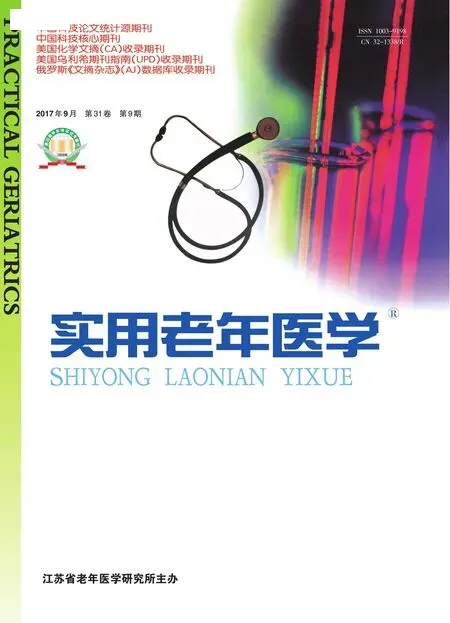脂蛋白相关磷脂酶A2与老年冠心病病人药物洗脱支架植入术后再狭窄的相关性
脂蛋白相关磷脂酶A2与老年冠心病病人药物洗脱支架植入术后再狭窄的相关性
陈芡茹尤威吴志明孟培娜张航陈羽乔石顺懿叶飞
目的探讨血清脂蛋白相关磷脂酶A2(lipoprotein-associated phospholipase A2,Lp-PLA2)水平与老年冠心病病人经皮冠状动脉介入治疗(pecutaneous coronary intervention,PCI)术后药物洗脱支架(drug-eluting stent,DES)内再狭窄(ISR)的相关性。方法选取102例经冠状动脉造影(coronary angiography,CAG)证实冠状动脉严重狭窄并行PCI术植入DES的老年冠心病病人,术后1年复查CAG显示支架段再次出现≥50%狭窄的病人11例为支架内再狭窄组(ISR组),CAG显示支架段内狭窄程度<50%或支架段内无狭窄的病人91例为非支架内再狭窄组(NISR组),比较2组病人的血脂及Lp-PLA2、超敏C反应蛋白(hypersensitive C-reactive protein,hs-CRP)等炎症指标水平。结果ISR组病人血清炎症指标Lp-PLA2为(333.09±91.07) ng/ml,明显高于NISR组的(228.52±113.34) ng/ml(P<0.05),但hs-CRP水平差异无统计学意义(P>0.05),总胆固醇和低密度脂蛋白胆固醇水平在2组中差异亦无统计学意义(P>0.05);Logistic回归分析显示Lp-PLA2水平是ISR的独立危险因素。结论Lp-PLA2可能是评估老年冠心病病人PCI术后ISR发生风险的独立预测因素之一。
老年人; 冠心病; 支架内再狭窄; 脂蛋白相关磷脂酶A2
经皮冠状动脉介入治疗(PCI)是目前针对冠状动脉严重狭窄的老年冠心病病人实施血运重建的最佳手段之一,但支架内再狭窄(ISR)和支架血栓(ST)仍然是PCI术后的主要严重并发症[1]。ISR可由多种因素引起,其中持续的血管炎症可能参与其发生和发展[2]。血清脂蛋白相关磷脂酶A2(Lp-PLA2)是由参与动脉粥样硬化过程中的各种炎症细胞如巨噬细胞、T淋巴细胞和单核细胞等所分泌的一种酶,对血管炎症具有高度特异性[3]。本文通过检测老年冠心病病人的Lp-PLA2水平,探讨ISR与Lp-PLA2之间的关系。
1 材料与方法
1.1 研究对象 选取102例住我院心内科经冠状动脉造影(CAG)确诊冠脉严重狭窄(>75%)并行PCI术的老年冠心病病人,年龄60~90岁,其中男68例,女34例,所有病人术后均予双联抗血小板和他汀治疗。随访1年后于我院行CAG复查,结果显示支架段再次出现≥50%的直径狭窄的病人共11例,定义为支架内再狭窄组(ISR组),其中男5例,女6例,年龄65~82岁,平均(70.27±7.42)岁;其他91例为非支架内再狭窄组(NISR组),其中男63例,女28例,年龄60~90岁,平均(69.15±6.69)岁。排除标准:临床资料不全、既往有多次PCI或冠状动脉旁路移植术史、炎症性疾病、甲状腺疾病、严重心力衰竭[左心室射血分数(LVEF)<35%]、严重肝肾功能不全病人。
1.2 研究方法 (1)所有病人入院后测量身高、体质量等,计算体质量指数(BMI)。(2)复查CAG前空腹留取静脉血送检验科化验,使用AU5800系列全自动生化分析仪(贝科曼库尔特公司)检测血糖、血脂水平,采用酶联免疫吸附试验检测超敏C反应蛋白(hypersensitive C-reactive protein,hs-CRP)水平。(3)采用比浊法检测血清Lp-PLA2水平,试剂盒由南京诺尔曼生物有限公司提供,严格按照试剂盒说明书进行操作。(4)CAG及冠状动脉狭窄程度评价:采用标准Judkins法,根据AHA/ACC规定的冠状动脉血管图像分段计分评价标准,应用CAAS5.9定量冠状动脉测量系统对植入支架处冠脉狭窄程度进行定量评估。

2 结果
2.1 2组间临床基线资料比较 2组间年龄、吸烟、合并高血压、糖尿病等基线资料差异无统计学意义(P>0.05);ISR组病人的高密度脂蛋白胆固醇(HDL-C)水平较低,与NISR组比较,差异有统计学意义(P<0.01),但2组间低密度脂蛋白胆固醇(LDL-C)、总胆固醇(TC)、甘油三酯(TG)等水平差异无统计学意义(P>0.05);ISR组病人的Lp-PLA2水平明显升高,与NISR组相比,差异有统计学意义(P<0.01),见表1。

表1 2组间临床基线资料比较
续表:

项目ISR组(11例)NISR组(91例)HDL-C(x±s,mmol/L)0.91±0.23**1.15±0.28空腹血糖(x±s,mmol/L)7.42±3.306.15±2.35血小板计数(x±s,×109/L)168.18±69.15176.22±47.57LVEF(x±s,%)59.73±6.4161.64±5.41hs-CRP(x±s,μg/ml)2.23±2.071.26±1.05Lp-PLA2(x±s,ng/ml)333.09±91.07**228.52±113.34
注:与 NISR组比较,**P<0.01
2.2 ISR的独立危险因素分析 为观察各种危险因素对ISR的预测价值,以是否发生ISR为因变量,以年龄、高血压、糖尿病、LDL-C、HDL-C、hs-CRP、Lp-PLA2为协变量,进行逐步Logistic回归分析,结果显示Lp-PLA2与ISR独立相关,OR=1.008,95%CI(1.001~1.015),见表2。
2.3 Lp-PLA2对ISR的预测价值 ROC曲线显示预测ISR的最佳Lp-PLA2界值为251.5,曲线下面积为0.768,95%CI为0.650~0.885,灵敏度为90.9%,特异度为65.9%,见图1。

表2 ISR危险因素的Logistic回归分析

图1 Lp-PLA2对ISR的ROC曲线
3 讨论
近年来由于PCI术的开展,冠心病病人的治疗取得了极大的进步,尤其是药物洗脱支架(DES)的应用显著降低了ISR和靶病变血运重建(target lesion revascularization,TLR)的发生率,但目前仍然不能根除ISR的发生。ISR是PCI术后支架失败的主要原因之一,有研究表明ISR相关的心肌梗死发生率高达2%~19%[4]。过度的支架内新生内膜增生(in-stent neointimal hyperplasia,NIH)是导致早期ISR的主要因素[5]。由于血管对DES表面的聚合物产生的过敏反应和药物本身对血管的损害导致新生内膜组织中聚集更多的炎症细胞,而这种慢性炎症在通过削弱内膜修复来抑制支架表面内皮化的同时也促进了血管修复过程中的异质性增生。同样PCI术中无法避免的撕裂及挤压斑块、球囊扩张、支架释放等导致局部血管壁损伤,从而通过炎症反应诱发或加快了支架表面的内膜增生[6]。因此,血管炎症反应在动脉损伤后的内膜增生中扮演着重要角色[7]。动物实验也证实,PCI术后血管内皮损伤刺激内皮细胞诱导早期炎症反应,数天和数周后巨噬细胞入侵正在形成的新生内膜并且聚集在支架钢梁周围[8]。因此我们有理由假设炎症反应越严重,内膜增生越明显。
Lp-PLA2是由动脉粥样斑块中的各种炎症细胞如巨噬细胞、T淋巴细胞和单核细胞等所分泌的一种酶,可将氧化低密度脂蛋白(oxidative-LDL,ox-LDL)分解为2种具有促炎和促动脉硬化作用的产物—溶血卵磷脂胆碱(lysophosphatidylcholine,Lyso-PC)和氧化非酯化脂肪酸(oxidized non-esterified fatty acids,oxNEFAs),而Lyso-PC和oxNEFAs通过使炎症细胞聚集、血小板激活和聚集、削弱内皮功能和增强平滑肌细胞增生进而导致新生内膜形成和再狭窄。目前研究已经证实斑块中的Lp-PLA2和血液循环中的Lp-PLA2水平是高度相关的[9],血清Lp-PLA2水平可以敏感并精确地反映血管炎症的严重性。Zheng等[10]发现升高的血清Lp-PLA2水平与ISR的发生风险相关,且Lp-PLA2水平可能预测PCI术后ISR的发生风险。本研究同样发现,ISR组病人的Lp-PLA2水平明显升高,且是ISR发生风险的独立预测因素,尤其是Lp-PLA2水平升高至251.5 mmol/L以上后发生ISR的风险更高;同时研究发现hs-CRP水平与ISR无明显相关性,可能与hs-CRP并非是反映血管炎症的特异性指标,受到多种因素如潜在或近期感染的影响有关。但Moldoveanu等[11]研究发现,Lp-PLA2水平与ISR的发生没有相关性,可能是由于该研究的随访时间较短,而且其研究对象为已经发生ISR的病人,再次于ISR处行PCI术后发生NIH的机制可能与原发病变处不同。
本研究发现Lp-PLA2水平与ISR的发生风险相关,且Lp-PLA2水平越高,发生ISR的风险越高。这也提示我们临床医生在针对老年冠心病病人PCI术后积极双联抗血小板治疗的同时,应该强化他汀治疗,力求血脂达标的同时亦改善炎症指标,以期降低PCI术后ISR的发生率,进而改善老年病人的长期预后。
[1] Moses JW, Leon MB, Popma JJ, et al.Sirolimus-eluting stents versus standard stents in patients with stenosis in a native coronary artery[J]. N Engl J Med, 2003, 349(14):1315-1323.
[2] Park SJ, Kang SJ, Virmani R, et al.In-stent neoatherosclerosis: a final common pathway of late stent failure[J].J Am Coll Cardiol, 2012,59(23):2051-2057.
[3] Ikonomidis I, Michalakeas CA, Lekakis J, et al. The role of lipoprotein-associated phospholipase A2 (Lp-PLA2) in cardiovascular disease[J].Rev Recent Clin Trials, 2011, 6(2):108-113.
[4] Windecker S, Juni P. Safety of drug-eluting stents[J].Nat Clin Pract Cardiovasc Med, 2008, 5(6):316-328.
[5] Stefanini GG, Holmes DR Jr. Drug-eluting coronary-artery Stents[J].N Engl J Med, 2013, 368(3):254-265.
[6] Finn AV, Joner M, Nakahashi T, et al. Pathological correlates of late drug-eluting stent thrombosis:strut coverage as a marker of endothelialization[J]. Circulation, 2007, 115(18):2435-2441.
[7] Guerra E, Byrne RA, Kastrati A. Pharmacological inhibition of coronary restenosis: Systemic and local approaches[J].Expert Opin Pharmacother, 2014,15(15):2155-2171.
[8] Li J, Ren L, Zhang S, et al.Cu-bearing steel reduce inflammation after stent implantation[J].J Mater Sci Mater Med, 2015, 26(2):114.
[9] Colley KJ, Wolfert RL, Cobble ME. Lipoprotein associated phospholipase A2:role in atherosclerosis and utility as a biomarker for cardiovascular risk[J].EPMA J, 2011, 2(1):27-38.
[10]Zheng D, Zeng F, Cai A, et al. Baseline elevated Lp-PLA2 is associated with increased risk for re-stenosis after stent placement[J].Lipids Health Dis, 2014,13:41.
[11]Moldoveanu E, Mut-Vitcu B, Tanaseanu GR, et al. Low basal levels of circulating adiponectin in patients undergoing coronary stenting predict in-stent restenosis, independently of basal levels of inflammatory markers: lipoprotein associated phospholipase A2,and myeloperoxidase[J].Clin Biochem, 2008, 41(18):1429-1433.
Relationshipbetweenserumlipoprotein-associatedphospholipaseA2andintra-stentrestenosisafterdrug-elutingstentimplantationinelderlypatientswithcoronaryheartdisease
CHENQian-ru,YOUWei,WUZhi-ming,MENGPei-na,ZHANGHang,CHENYu-qiao,SHIShun-yi,YEFei.
DepartmentofVasculocardiology,NanjingHospitalAffiliatedtoNanjingMedicalUniversity,Nanjing210006,China
ObjectiveTo investigate the relationship of serum lipoprotein-associated phospholipase A2 (Lp-PLA2) with intra-stent restenosis (ISR) after drug-eluting stents (DES) implantation in elderly patients with coronary heart disease.MethodsTotally one hundred and two elderly patients with severe coronary artery stenosis confirmed by coronary angiography (CAG) and treated with DES implantation were enrolled. All participants were followed up for at least 1 year and divided into ISR group which was defined as≥50% restenosis of reference vessel diameter at stent segment and nonintra-stent restenosis (NISR) group which was defined as <50% restenosis of reference vessel diameter or no restenosis at stent segment according to the consequence of CAG. The levels of lipid and inflammatory factors such as Lp-PLA2, hypersensitive C-reactive protein (hs-CRP) were detected and compared between two groups.ResultsThe serum level of Lp-PLA2 was significantly higher in ISR group compared with NISR group(333.09±91.07 ng/ml vs. 228.52±113.34 ng/ml,P<0.05). But the level of hs-CRP was not significantly different between two groups(P>0.05). No difference was found in the levels of total cholesterol and low density lipoprotein-cholesterol between two groups (P>0.05). Logistic regression analysis showed serum level of Lp-PLA2 was an independent predictor of ISR.ConclusionsSerum level of Lp-PLA2 may be one of independent predictors in elderly patients with coronary heart disease who are at increased risk for restenosis after drug-eluting stent placement.
aged; coronary heart disease; intra-stent restenosis; lipoprotein-associated phospholipase A2
210006江苏省南京市,南京医科大学附属南京医院(南京市第一医院)心血管内科
叶飞,Email:yefei@medmail.com.cn
R 541.4
A
10.3969/j.issn.1003-9198.2017.09.009
2016-09-13)

